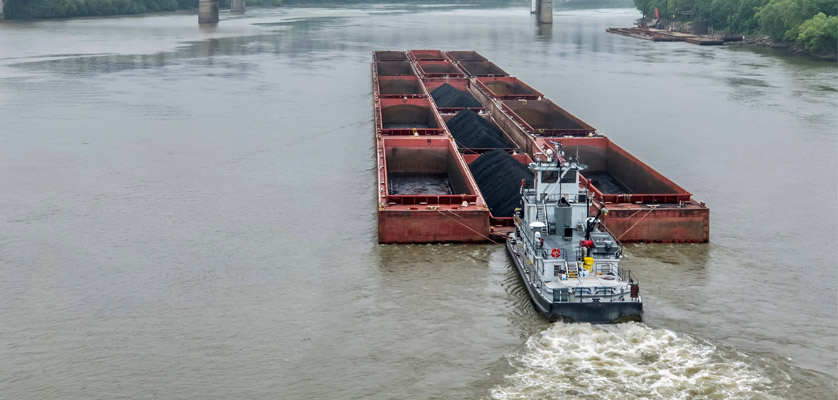Coal Transportation: The River Barge
Rivers and lakes have always played a big role in the bulk transportation of coal - particularly in European countries such as The Netherlands, Germany, France and Belgium and also across the United States and Canada.
Each barge offers an average capacity of up to 1,500 tons. Although waterways are a reliable form of transport, they have a slower delivery time than other common methods, such as rail transportation. However, barge transport remains popular because it is extremely cost-efficient.

© Jonathan / Adobe Stock
Transport costs
The cost of barge transportation depends on the size of the river or waterway, as this governs the number of coal barges that can be towed by each single boat. For example, in the US, rivers such as the upper Mississippi, Ohio, Cumberland and Tennessee can hold 20 to 25 barges per towboat.
By contrast, the lower Mississippi can take up to 35 barge tows. Considering each barge has a capacity of up to 1,500 tons, this means it becomes massively cost-efficient to transport the load via the bigger waterways when possible.
Transporting coal on rivers and lakes is a key element of domestic coal distribution. It accounts for 20% of coal transportation, which equates to approximately 306 million tons. This has remained constant for around the past 15 years.
Major coal-producing regions
It is most important in the United States, along the Ohio River, where 80% of coal shipments originate. There are a large number of coal mines, electricity-generating facilities and riverside loading and unloading stations along the river banks as a result.
Many of the coal exports from this region move across the Great Lakes to Canada. These lake transportations have remained constant throughout the 21st century.
Coal arrives at the water ports by rail and is unloaded from the trains, before being re-loaded on to the barges for delivery to the distribution centres and ultimately the consumers. Much of the coal goes principally to electricity generating stations.
When it comes to river barge transportation, maintenance of the inland waterways structure is crucial to keep the industry going. Construction and maintenance projects on the waterways continue on a rolling basis. This has been the case since the 1970s.
Hydraulic systems
The smooth running of the river barges is dependent on their hydraulic systems. On canal boats, there are many different applications for hydraulic systems. These include bespoke roof-lifting systems, so the barges can manage the often-tight squeezes under bridges. There are also hydraulic manoeuvring systems, enabling the user to move heavy loads, such as tons of coal.
The full range of applications of hydraulic systems on barges is staggering. Hydraulic winches tow and lift extremely heavy loads, making everyday jobs much easier. Thrusters are used to improve the boat's manoeuvring, creating a propeller or a secondary jet onboard the barge. As well as thrusters, a joystick control makes steering the boat more manageable.
Power steering helps to speed up the response time of the wheel when it comes to steering the river barge - a canal boat is steered the same way as a car, with the wheel controlling its direction, but on the water, the response time is much slower.
UK coal transportation
In England and Wales, there are around 2,000 miles of canals, from the narrower canal network, taking vessels carrying up to 25 tons to the major ship canals and tidal estuaries. According to the Commercial Boat Operators' Association, coal deliveries by boat cover both wholesale and retail solid fuels markets in Britain.
One of the busiest loading wharfs in the West Midlands is aimed at boats travelling as far afield as Gloucester, Northwich and Oxford. Other barges operate in Northamptonshire, Cheshire, the Thames Valley, the South East and London. Around 19 tons of fuel is carried per barge per trip, making it a cost-effective service.
If you would like more information about Phoenix Hydraulics' complete range of hydraulic components and services, contact us for further information.
We stock more than 70,000 products, ready for immediate delivery. We have been established for more than 35 years and have grown to be one of the UK’s largest independent hydraulics companies.


